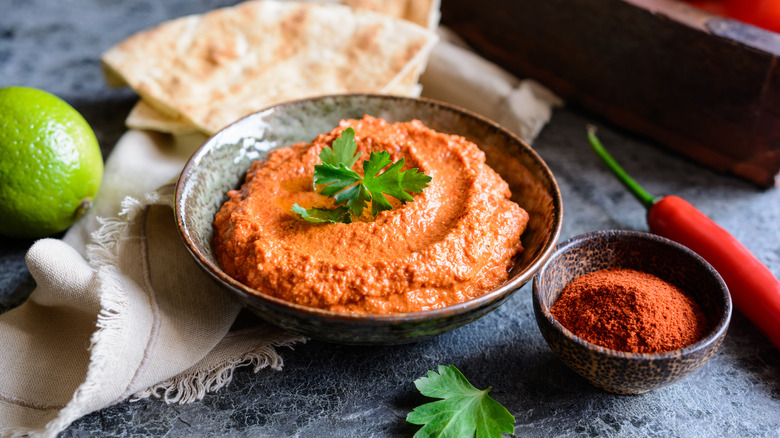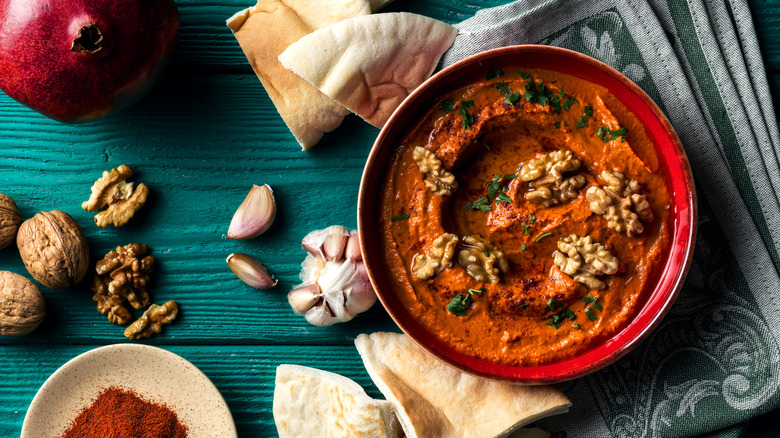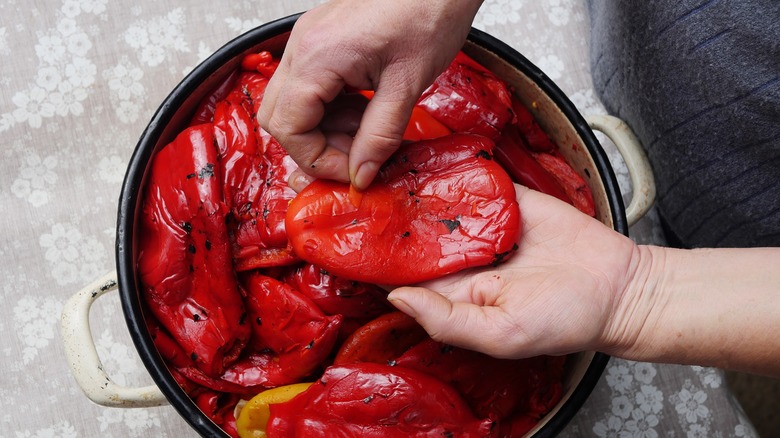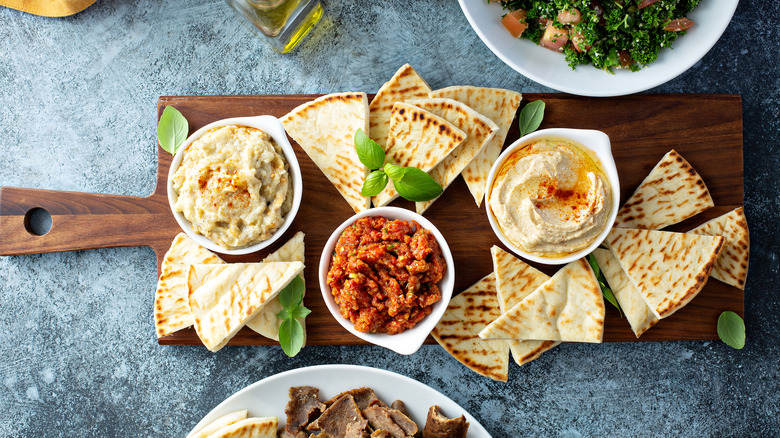The Rustic Syrian Dip Bursting With Peppers And Spices
Move over hummus; there's a new Middle Eastern dip taking over pita platters, being spread over sandwiches, and topping kebabs these days. If you're a fan of roasted red pepper hummus or Spain's famed romesco sauce, then digging into Syria's own muhammara dip is an essential next step for you. This all-in-one spicy, nutty, slightly sweet, and earthy dip experience has the perfect blend of complex flavors you've been looking for to complete your next Middle Eastern spread.
According to The Mediterranean Dish, muhammara originates from the Arabic word "ahmar," which translates to red in English. A fitting name for this Syrian roasted red bell pepper dip, which originates from the country's once-largest city of Aleppo. While Aleppo is the birthplace of the dish, it has become increasingly popular and has spread around to many other Middle Eastern nations, such as Turkey and Lebanon. It has also made its way to the European and North American markets as well, as The Kitchn notes.
As per The Kitchn, unlikely pairings blend together in this sweet-and-spicy dip that brings it to the next level. From slightly smoky notes from the roasted red peppers to the earthy components brought on by the slightly bitter walnuts, this savory dip's flavor is totally unique. And, with a generous drizzle of tangy pomegranate molasses and a sprinkle of Aleppo pepper, a fruity acidity and hint of spice completes this dish.
Ingredients in muhammara
According to The Mediterranean Dish, there's an array of unique ingredients thrown into this dip that work perfectly together to achieve an ideal balance of flavors. The main ingredient, of course, is roasted red bell peppers. We always recommend roasting your own if you're diving into making muhammara homemade. Although, there's always the option of store-bought roasted pepper jars. MasterClass notes that five red bell peppers will make about 10 servings of dip.
Next on the ingredients list, as per MasterClass, is a chopped white onion, plum or Roma tomatoes, and a red chili. These ingredients add both acidity and robustness essential to the dip. Lots of olive oil is added to aid the blending process and help achieve a silky texture. The Mediterranean Dish also notes that bread crumbs are also often mixed in to thicken the dip and "add heft" to the texture.
As for additional flavoring, lots of spices are a must. MasterClass's ingredient list includes black pepper, tomato paste, cumin seeds, coriander seeds, garlic, pomegranate molasses, chopped walnuts, and pomegranate seeds. Extra pomegranate molasses, walnuts, and parsley are essential garnishes for additional flavor. The molasses adds a much-needed sweetness and fruitiness to the dish, while the nuts add an earthiness and the parsley adds an herby freshness. As per The Mediterranean Dish, Aleppo pepper flakes are also typically added for spice into the blended for a mild spice and a hint of additional fruitiness.
How muhammara is made
The first step to perfecting a muhammara recipe is freshly roasting red bell peppers. There are a few ways to do this, and they're all beginner relatively easy to master. We recommend roasting them over a flame if possible, whether on a gas stove or a grill. Read our article to discover how.
According to The Kitchn, once the peppers are blackened, they're transferred to a bowl, covered, and left to steam. Once adequately steamed, the black skin is removed along with any stems and seeds. Then, large pepper pieces are tossed into a food processor along with garlic, lemon juice, bread crumbs, olive oil, pomegranate molasses, Aleppo pepper flakes, salt, cumin, and sugar.
The mixture is blended until it is almost completely smooth in texture. Once blended, the muhammara can be poured into a serving bowl with toasted and coarsely chopped walnuts and more pomegranate molasses to garnish, as per The Kitchn.
How muhammara is eaten
According to MasterClass, muhammara is traditionally served as an appetizer and can be paired with crudités or pita (your choice of bread or chips) for dipping. These pairings are perfect for including in your next mezze spread, a tapa-adjacent style of dining that is popular in the Middle East, which includes many small plates that function as aperitifs and make up the entire meal, according to The Spruce Eats.
However, if you're looking for a bit more of an unconventional use for the dip, Caroline's Cooking notes that muhammara is great for adding a bit more flavor to your quickly thrown-together sandwiches or wraps. Muhammara is a great condiment that can easily be spread on a sandwich or pita bread. Try it on a juicy lamb burger or tasty chicken shawarma.
The site also recommends serving the dip on grilled meat, fish, or various vegetables. From grilled chicken kebabs to roasted cauliflower, we advise getting as creative as possible with your pairings.
Whether you're looking to spice things up at the dinner table, experiment with new spreads for sandwiches, or throw together an authentic Syrian feast, muhammara is a great addition to any mealtime menu.



